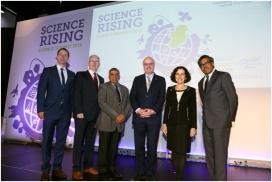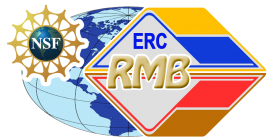US-Ireland-Northern Ireland Partnership Targets Advances in Orthopedic Implant Devices
The National Science Foundation (NSF)-funded Engineering Research Center (ERC) for Revolutionizing Metallic Biomaterials (RMB), headquartered at North Carolina A&T University (NCAT), formed a Centre-to-Centre (C2C) tripartite collaborative partnership with the Science Foundation Ireland (SFI) Centre for Research in Medical Devices (CÚRAM) in the Republic of Ireland (ROI), and the Nanotechnology and Integrated Bioengineering Centre (NIBEC) at Ulster University in Northern Ireland (NI). The partnership, which was established under the auspices of the US-Ireland R&D program in November 2016, is supported by U.S. industrial partners OrthoKinetic Technologies LLC, OrthoKinetic Testing Technologies LLC (Ortho Kinetics, Inc., Shallotte, NC) and Ft. Wayne Metals (FWM, Ft. Wayne, IN).
This tripartite partnership creates a unique convergence of world-leading expertise from academia and industry in the fields of materials processing, surface characterization, and computational modeling to speed development of bioresorbable magnesium (Mg) alloy systems for orthopedic implant devices. Concurrent with the research, the C2C is envisioning study-abroad opportunities and as well as transatlantic offerings of seminars and lectures to prepare the next-generation workforce for the global knowledge economy. Ultimately, such collaboration will promote “outside the box” thinking skills in the 21st century workforce, and will aid individuals to find permanent employment in a wide range of industrial and governmental positions. As such, this tripartite collaboration can have a strong impact on the next-generation workforce, with particular emphasis on the students gaining opportunities for study abroad and to spend time conducting research activities at the industrial partner research sites (USA, ROI, and NI).
Each partner in the collaboration shares the goal of developing bioresorbable orthopedic implants made from novel high-strength, high-ductility magnesium and magnesium alloy systems that can replace the permanent metals/metal alloys usually used in applications ranging from thin wires to thicker pins, rods, and elastic stable intramedullary nails (ESINs), as well as meshes for the treatment of complex bone fractures. The C2C will use both existing high purity magnesium systems and new magnesium alloys that are currently being developed by the NSF-ERC-RMB using novel processing methods (patents pending). In addition to using them in their inherent state, C2C will employ advanced surface modification and coating procedures developed at NIBEC at Ulster University to control key interfacial properties for the clinical applications concerned and use bespoke finite element models developed at CÚRAM at the National University of Ireland, Galway (NUIG) to provide the data to target multiple applications by varying bulk and surface properties.



